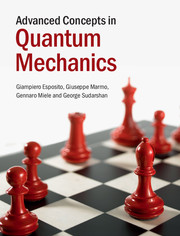Book contents
- Frontmatter
- Contents
- Preface
- 1 Introduction: the need for a quantum theory
- 2 Experimental foundations of quantum theory
- 3 Waves and particles
- 4 Schrödinger picture, Heisenberg picture and probabilistic aspects
- 5 Integrating the equations of motion
- 6 Elementary applications: one-dimensional problems
- 7 Elementary applications: multi-dimensional problems
- 8 Coherent states and related formalism
- 9 Introduction to spin
- 10 Symmetries in quantum mechanics
- 11 Approximation methods
- 12 Modern pictures of quantum mechanics
- 13 Formulations of quantum mechanics and their physical implications
- 14 Exam problems
- 15 Definitions of geometric concepts
- References
- Index
13 - Formulations of quantum mechanics and their physical implications
Published online by Cambridge University Press: 05 November 2014
- Frontmatter
- Contents
- Preface
- 1 Introduction: the need for a quantum theory
- 2 Experimental foundations of quantum theory
- 3 Waves and particles
- 4 Schrödinger picture, Heisenberg picture and probabilistic aspects
- 5 Integrating the equations of motion
- 6 Elementary applications: one-dimensional problems
- 7 Elementary applications: multi-dimensional problems
- 8 Coherent states and related formalism
- 9 Introduction to spin
- 10 Symmetries in quantum mechanics
- 11 Approximation methods
- 12 Modern pictures of quantum mechanics
- 13 Formulations of quantum mechanics and their physical implications
- 14 Exam problems
- 15 Definitions of geometric concepts
- References
- Index
Summary
In this chapter, the physical content of previous chapters is summarized, and the reader is suided towards some key areas of modern physics: the Feynman formulation, the unificaton of quantum theory with special relativity, and dualities in quantum mechanics. This very short chapter is intended to be a bridge aimed at motivating readers to attend first course in quantum field theory.
Towards an overall view
At this stage, the student or the general reader might want to know what picture of the physical world emerges from the material covered so far and from the areas related to it but not covered in our book, so as to be introduced to what is in sight not only for the beginner but also for the scientific community. For this purpose, we summarize very briefly the previous pictures and we arrive at three key concepts: the Lagrangian in quantum mechanics via the Feynman sum over histories; the unification of quantum mechanics and special relativity; and new duality symmetries in quantum mechanics.
From Schrödinger to Feynman
Quantum mechanics provides a probabilistic description of the world on atomic or sub-atomic scale. It tells us that, on such scales, the world can be described by a Hilbert space structure, or suitable generalizations. Even in the relatively simple case of the hydrogen atom, the appropriate Hilbert space is infinite-dimensional, but finite-dimensional Hilbert spaces play a role as well.
- Type
- Chapter
- Information
- Advanced Concepts in Quantum Mechanics , pp. 339 - 352Publisher: Cambridge University PressPrint publication year: 2014



